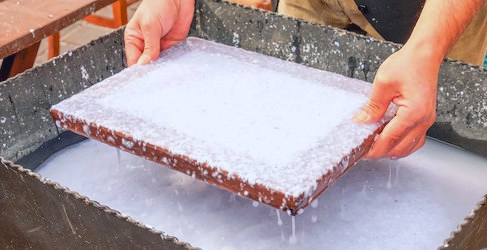Paper Sizing - what is it all about?
Posted by Mark Walker on 11th Jun 2024

Sizing in papermaking is a crucial process that influences the paper's performance and characteristics. It involves treating the paper fibres with a variety of substances to control the paper's absorbency and strength. Sizing can be applied externally, known as surface sizing, or internally, referred to as internal sizing.
Surface sizing is the application of chemicals onto the surface of the paper after it has been formed. This process helps to reduce the paper's absorbency, making it more resistant to water and ink penetration. Surface sizing is commonly used for papers intended for watercolour, ink, and other wet media, ensuring that the colours remain vibrant and do not bleed excessively.
Internal sizing, on the other hand, involves adding agents directly to the pulp during the papermaking process. This ensures that the sizing is distributed evenly throughout the paper, providing uniform protection against moisture and atmospheric acids, and enhancing the paper's strength and durability. Internal sizing is crucial for papers used in printing, writing, and other applications where dimensional stability and ink holdout (not absorbing too quickly) are essential.
Common chemicals used in paper sizing include:
- Gelatin: Traditional sizing agent derived from animal collagen, providing excellent surface strength, colour vibrancy and ink holdout.
- Gum arabic: Natural gum extracted from acacia trees, used to improve the paper's wet strength and enhance colour vibrancy.
- Alum: Aluminumsulfate, commonly used in internal sizing to enhance water resistance and strength.
- Calcium or magnesium carbonate: These compounds are widely used as an alkaline buffer in papermaking. They help neutralize acids that may be present in the paper pulp or absorbed from the environment, thereby maintaining the paper's pH stability.
- Starch: Typically used in surface sizing, starch provides a smooth surface and improves the paper's holdout.
- Synthetic sizing agents: These include compounds like alkyl ketene dimer (AKD) and alkyl succinic anhydride (ASA), which are used in both internal and surface sizing to enhance water resistance and strength.
- Polyvinyl acetate (PVA): This synthetic polymer is used in surface sizing to improve the paper's surface strength and water resistance.
- Polyethylene glycol (PEG): Another synthetic polymer, PEG is used in internal sizing to improve water resistance and reduce surface roughness.
Watercolor papers are sized to control the absorbency of the paper and prevent the paint from being absorbed too quickly, allowing for better colour control especially when doing washes. Surface sizing also helps with lifting techniques. Gelatin is particularly commonly used for this on the surface. Some papers are double or heavily sized this technique enhances the paper's ability to resist water and improves its overall strength and durability.
Printmaking papers more rely on internal sizing and may be only lightly surface sized. Internal sizing allows papers to be soaked without falling apart. However, there are significant differences between papers. Arches 88, for instance is not sized and will only withstand very light spraying with water before printing. Somerset papers have both surface and internal sizing. Hahnemuhle etching paper is heavily internally sized and can be heavily soaked.
Most art papers are sized. Understanding sizing helps to determine how to use the paper and identify why papers behave differently to each other.













